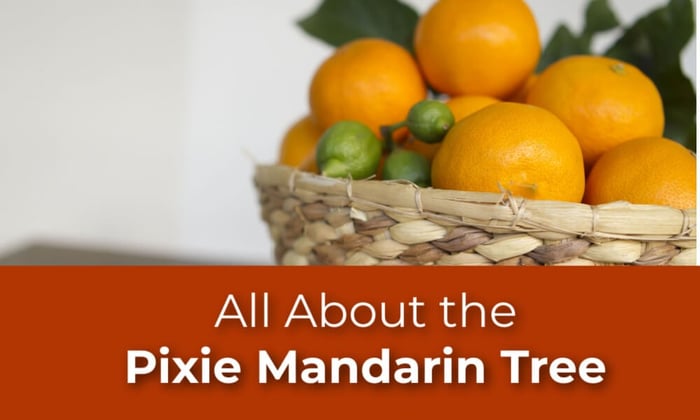The Tahoe Gold Mandarin tree, also known as the Tahoe Gold Tangerine tree, is a citrus fruit tree prized for its sweet and flavorful fruit. The tree grows vigorously and is somewhat spreading in form, with a tendency to alternate bearing. Tahoe Gold (tm) is a hybrid with Temple tangor, and Dancy and Encore mandarins in its parentage. The large oblate fruits have a dark orange rind that is relatively thin. The fruit of the Tahoe Gold Mandarin tree is known for its excellent flavor. It is typically sweet, with a rich and tangy taste. The flesh is juicy and has a slightly floral aroma. The fruit is seedless, bright orange, finely-textured and juicy. The flavor is often described as a blend of tangerine and mandarin, making it a delightful and refreshing citrus variety.
Tahoe Gold Mandarins typically ripen in the late fall to early winter, usually from November to January. The exact timing can vary depending on local climate and growing conditions. The Tahoe Gold Mandarin tree is generally considered to be hardy, suitable for growing in USDA hardiness zones 9-10. It can tolerate temperatures down to around 32°F, and it is sensitive to frost and cold weather. Therefore, it's important to protect the tree during cold snaps, especially if you live in an area prone to freezing temperatures. Consider providing frost protection, such as covering the tree with frost cloth or bringing it indoors during extremely cold nights.
To grow a Tahoe Gold Mandarin tree in a pot, follow these steps:
1. Select a Suitable Pot: Choose a large, sturdy container with good drainage. The pot should be at least 10-14” inches in diameter and have lots of drainage holes at the bottom. Here is appropriate sized pot for a starter, or primo, sized citrus tree.
2. Planting in a Pot: Use a well-draining, high-quality potting mix suitable for citrus trees, such as our DIY Primo Potting Mix. This mix should provide good aeration for the roots and retain moisture without becoming waterlogged.
3. Planting in the ground: For in-ground planting, plant the tree in a prepared area about 3x the diameter of the pot, and as deep as possible. That soil should be well-draining and loose, allowing for root growth. To plant your tree, dig a hole that it twice the size of the root ball and at the same depth as the pot, keeping the crown of the roots just above the soil line. Water thoroughly after planting.
4. Location: Place the potted tree in a sunny location where it can receive at least 6-8 hours of direct sunlight daily. Citrus trees need plenty of sunlight to thrive.
5. Watering: Keep the soil consistently moist but not soggy. Water the tree when the top inch of soil feels dry, but avoid overwatering, which can lead to root rot.
6. Fertilization: Fertilize your Tahoe Gold Mandarin tree with a balanced, slow-release fertilizer according to the manufacturer's instructions. Typically, citrus trees benefit from fertilization in the spring and late summer. You do not need to fertilize during the cold months.
7. Pruning: Prune your tree as needed to maintain its shape and remove any dead or diseased branches.
8. Pest and Disease Management: Keep an eye out for common citrus pests like aphids, mealybugs, and scale insects. Regularly inspect the tree and treat any infestations promptly with remedies such as neem oil or Captain Jack's Insecticidal Soap.
By following these care guidelines, you can successfully grow a Tahoe Gold Mandarin tree in a pot and enjoy its delicious fruit when it ripens in the late fall to early winter.
Click here to see Tahoe Gold Mandarin Trees.
$65.00
--OVERVIEW-- Now available! 36"-48" Premium Tahoe Gold Semi-Dwarf Mandarin Trees Mid-Season Ripening Mandarin Tahoe Gold is a juice-packed mandarin with an excellent sweet-tart flavor that melts in your mouth as you enjoy this delicate, easy-to-peel fruit. This seedless variety was… read moreTahoe Gold Semi-Dwarf Mandarin Tree





